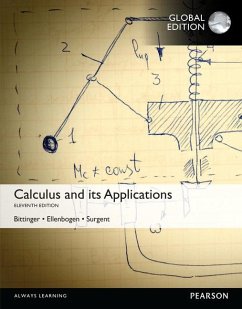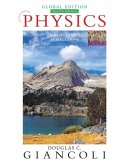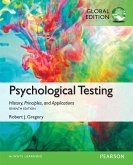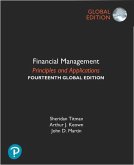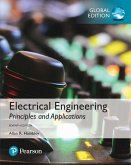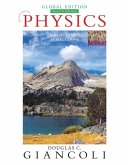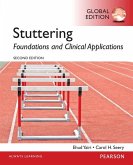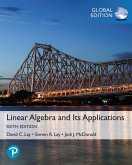For one-semester courses in applied calculus.
Anticipating and meeting student needs
Calculus and Its Applications, Eleventh Edition, remains a best-selling text because of its accessible presentation that anticipates student needs. The writing style is ideal for today’s students, providing intuitive explanations that work with the carefully crafted artwork to help them visualize new calculus concepts. Additionally, the text’s numerous and up-to-date applications from business, economics, life sciences, and social sciences help motivate students. Algebra diagnostic and review material is available for those who need to strengthen basic skills. Every aspect of this revision is designed to motivate and help students to more readily understand and apply the mathematics.
MyMathLab not included. Students, if MyMathLab is a recommended/mandatory component of the course, please ask your instructor for the correct ISBN and course ID. MyMathLab should only be purchased when required by an instructor. Instructors, contact your Pearson representative for more information.
MyMathLab is an online homework, tutorial, and assessment product designed to personalize learning and improve results. With a wide range of interactive, engaging, and assignable activities, students are encouraged to actively learn and retain tough course concepts.
Features + Benefits
This title is a Pearson Global Edition. The Editorial team at Pearson has worked closely with educators around the world to include content which is especially relevant to students outside the United States.
About this Textbook
An intuitive approach to introducing the concepts builds on students’ earlier mathematical experience or a new experience presented by the authors before the concept is formalized. The writing style addresses students in a direct, down-to-earth manner.
The accessible, visual presentation helps students to navigate easily through the book. Artwork and figures are an integral part of the intuitive introductions to calculus concepts.
Algebra diagnostic and review material is available for students who need to strengthen their basic skills.
Prerequisite Skills Diagnostic Test at the beginning of the text gives a convenient way to assess strengths and weaknesses. Answers at the back of the book direct students to the appropriate algebra remediation sections within the text.
Algebra review is provided at two levels: Appendix A addresses the basics, while Chapter R addresses functions, graphs, and models.
Exponential and log functions are presented later (in Chapter 3), allowing students to focus more directly on the development of the derivative in Chapters 1 and 2 while using polynomial functions.
Section support features give students the help they need without getting in the way.
Objectives are listed at the beginning of each section, providing a roadmap of the material ahead.
Quick Check exercises after examples provide students with a way to check understanding at key junctures in the section.
Section Summaries help students pull together the key ideas of the section prior to working the exercises. These appear just prior to exercise sets.
Abundant section exercises give students the practice they need to understand and master the concepts. Exercises address basic skills and build conceptual understanding through a variety of exercise types including skills, applications, synthesis problems, thinking/writing exercises, and technology connection exercises.
Technology is integrated but optional. The text allows for the utilization of graphing calculators, spreadsheets, and smartphone applications. All technology is clearly labeled and can be omitted as needs dictate.
Technology Connection features are designed with three distinct purposes: 1) learn a concept using technology, 2) check or verify a solution using technology, or 3) investigate a topic using technology.
Technology Connections Exercises are clearly labeled with an icon.
Extended Technology Applications at the end of the chapter provide a motivational context for students to apply what they’ve learned. These can be done individually or in a group setting.
Test preparation material at the end of every chapter is designed to help students excel on tests.
Chapter Summaries are redesigned to be more reference-like, helping students distill key ideas and prepare for tests.
Chapter Review exercises feature Concept Reinforcement, Review Exercises, and Synthesis Exercises. All exercises are keyed back to specific sections in the chapter to guide students towards assistance (and to help instructors in making assignments).
Chapter Tests are designed to mirror the tests typically administered in class.
Applications are grouped by discipline within the exercise sets, organized under the headings of Business/Economics, Life/Physical Science, Social Science, and General Interest, to show students the relevance of calculus to other disciplines.
Real data, especially pertaining to the business world, connects the concepts to students’ future careers.
NEW! Several topics in this edition are particularly relevant for business majors, including amortizations and annuities.
Chapter Snapshots at the beginning of the chapter include an application to draw students into the concepts covered in the chapter.
MyMathLab not included. Students, if MyMathLab is a recommended/mandatory component of the course, please ask your instructor for the correct ISBN and course ID. MyMathLab should only be purchased when required by an instructor. Instructors, contact your Pearson representative for more information.
Thousands of exercises regenerate algorithmically so students can have unlimited practice opportunities.
NEW! Hundreds of new exercises in the Eleventh edition MyMathLab course meet student needs for practice, applications, and conceptual development. Student usage data from the previous MyMathLab course helped inform what types of exercises were needed the most.
Interactive Figures help students visualize key concepts. Assignable Interactive Figure Exercises allow you to make the figures a part of homework assignments.
NEW! Integrated Review tools address gaps in prerequisite skills. Students can use this content independently, or instructors can target individual student needs by using the built-in diagnostic quizzes and Personalized Homework.
NEW! Basic skills tutorial videos within specific exercises address prerequisite skills for that exercise. These videos augment existing example videos (that address the content of that specific exercise) by focusing on the prerequisite skills needed for that exercise.
NEW! MathTalk Videos help motivate students by pointing out relevant connections to their majors–especially business. The videos feature Andrea Young from Ripon College (WI), a dynamic math professor (and actor!). The videos can be used as lecture starters or as part of homework assignments (in regular or flipped classes).
R. Functions, Graphs, and Models
R.1 Graphs and Equations
R.2 Functions and Models
R.3 Finding Domain and Range
R.4 Slope and Linear Functions
R.5 Nonlinear Functions and Models
R.6 Mathematical Modeling and Curve Fitting
Chapter Summary
Chapter Review Exercises
Chapter Test
Extended Technology Application Average Price of a Movie Ticket
1. Differentiation
1.1 Limits: A Numerical and Graphical Approach
1.2 Algebraic Limits and Continuity
1.3 Average Rates of Change
1.4 Differentiation Using Limits of Difference Quotients
1.5 The Power and Sum—Difference Rules
1.6 The Product and Quotient Rules
1.7 The Chain Rule
1.8 Higher-Order Derivatives
Chapter Summary
Chapter Review Exercises
Chapter Test
Extended Technology Application–Path of a Baseball: The Tale of the Tape
2. Applications of Differentiation
2.1 Using First Derivatives to Classify Maximum and Minimum Values and Sketch Graphs
2.2 Using Second Derivatives to Classify Maximum and Minimum Values and Sketch Graphs
2.3 Graph Sketching: Asymptotes and Rational Functions
2.4 Using Derivatives to Find Absolute Maximum and Minimum Values
2.5 Maximum—Minimum Problems; Business, Economics, and General Applications
2.6 Marginals and Differentials
2.7 Elasticity of Demand
2.8 Implicit Differentiation and Related Rates
Chapter Summary
Chapter Review Exercises
Chapter Test
Extended Technology Application–Maximum Sustainable Harvest
3. Exponential and Logarithmic Functions
3.1 Exponential Functions
3.2 Logarithmic Functions
3.3 Applications: Uninhibited and Limited Growth Models
3.4 Applications: Decay
3.5 The Derivatives of ax and loga x
3.6 A Business Application: Amortization
Chapter Summary
Chapter Review Exercises
Chapter Test
Extended Technology Application–The Business of Motion Picture Revenue and DVD Release
4. Integration
4.1 Antidifferentiation
4.2 Antiderivatives as Areas
4.3 Area and Definite Integrals
4.4 Properties of Definite Integrals
4.5 Integration Techniques: Substitution
4.6 Integration Techniques: Integration by Parts
4.7 Integration Techniques: Tables
Chapter Summary
Chapter Review Exercises
Chapter Test
Extended Technology Application–Business: Distribution of Wealth
5. Applications of Integration
5.1 Consumer Surplus and Producer Surplus
5.2 Integrating Growth and Decay Models
5.3 Improper Integrals
5.4 Probability
5.5 Probability: Expected Value; The Normal Distribution
5.6 Volume
5.7 Differential Equations
Chapter Summary
Chapter Review Exercises
Chapter Test
Extended Technology Application–Curve Fitting and Volumes of Containers
6. Functions of Several Variables
6.1 Functions of Several Variables
6.2 Partial Derivatives
6.3 Maximum—Minimum Problems
6.4 An Application: The Least-Squares Technique
6.5 Constrained Optimization
6.6 Double Integrals
Chapter Summary
Chapter Review Exercises
Chapter Test
Extended Technology Application–Minimizing Employees’ Travel Time in a Building
Cumulative Review
Appendix A: Review of Basic Algebra
Appendix B: Regression and Microsoft Excel
Table A: Areas for a Standard Normal Distribution
Answers
Index of Applications
Index
Additional Instructor’s Answers
Calculus and Its Applications: Expanded Version (ISBN: 978-0-321-83820-9) contains these additional chapters:
7. Trigonometric Functions
8. Differential Equations
9. Sequences and Series
10. Probability Distributions
For one-semester courses in applied calculus. Anticipating and meeting student needs Calculus and Its Applications, Eleventh Edition, remains a best-selling text because of its accessible presentation that anticipates student needs. The writing style is ideal for today's students, providing intuitive explanations that work with the carefully crafted artwork to help them visualize new calculus concepts. Additionally, the text's numerous and up-to-date applications from business, economics, life sciences, and social sciences help motivate students. Algebra diagnostic and review material is available for those who need to strengthen basic skills. Every aspect of this revision is designed to motivate and help students to more readily understand and apply the mathematics. MyMathLab not included. Students, if MyMathLab is a recommended/mandatory component of the course, please ask your instructor for the correct ISBN and course ID. MyMathLab should only be purchased when required by an instructor. Instructors, contact your Pearson representative for more information. MyMathLab is an online homework, tutorial, and assessment product designed to personalize learning and improve results. With a wide range of interactive, engaging, and assignable activities, students are encouraged to actively learn and retain tough course concepts.
Anticipating and meeting student needs
Calculus and Its Applications, Eleventh Edition, remains a best-selling text because of its accessible presentation that anticipates student needs. The writing style is ideal for today’s students, providing intuitive explanations that work with the carefully crafted artwork to help them visualize new calculus concepts. Additionally, the text’s numerous and up-to-date applications from business, economics, life sciences, and social sciences help motivate students. Algebra diagnostic and review material is available for those who need to strengthen basic skills. Every aspect of this revision is designed to motivate and help students to more readily understand and apply the mathematics.
MyMathLab not included. Students, if MyMathLab is a recommended/mandatory component of the course, please ask your instructor for the correct ISBN and course ID. MyMathLab should only be purchased when required by an instructor. Instructors, contact your Pearson representative for more information.
MyMathLab is an online homework, tutorial, and assessment product designed to personalize learning and improve results. With a wide range of interactive, engaging, and assignable activities, students are encouraged to actively learn and retain tough course concepts.
Features + Benefits
This title is a Pearson Global Edition. The Editorial team at Pearson has worked closely with educators around the world to include content which is especially relevant to students outside the United States.
About this Textbook
An intuitive approach to introducing the concepts builds on students’ earlier mathematical experience or a new experience presented by the authors before the concept is formalized. The writing style addresses students in a direct, down-to-earth manner.
The accessible, visual presentation helps students to navigate easily through the book. Artwork and figures are an integral part of the intuitive introductions to calculus concepts.
Algebra diagnostic and review material is available for students who need to strengthen their basic skills.
Prerequisite Skills Diagnostic Test at the beginning of the text gives a convenient way to assess strengths and weaknesses. Answers at the back of the book direct students to the appropriate algebra remediation sections within the text.
Algebra review is provided at two levels: Appendix A addresses the basics, while Chapter R addresses functions, graphs, and models.
Exponential and log functions are presented later (in Chapter 3), allowing students to focus more directly on the development of the derivative in Chapters 1 and 2 while using polynomial functions.
Section support features give students the help they need without getting in the way.
Objectives are listed at the beginning of each section, providing a roadmap of the material ahead.
Quick Check exercises after examples provide students with a way to check understanding at key junctures in the section.
Section Summaries help students pull together the key ideas of the section prior to working the exercises. These appear just prior to exercise sets.
Abundant section exercises give students the practice they need to understand and master the concepts. Exercises address basic skills and build conceptual understanding through a variety of exercise types including skills, applications, synthesis problems, thinking/writing exercises, and technology connection exercises.
Technology is integrated but optional. The text allows for the utilization of graphing calculators, spreadsheets, and smartphone applications. All technology is clearly labeled and can be omitted as needs dictate.
Technology Connection features are designed with three distinct purposes: 1) learn a concept using technology, 2) check or verify a solution using technology, or 3) investigate a topic using technology.
Technology Connections Exercises are clearly labeled with an icon.
Extended Technology Applications at the end of the chapter provide a motivational context for students to apply what they’ve learned. These can be done individually or in a group setting.
Test preparation material at the end of every chapter is designed to help students excel on tests.
Chapter Summaries are redesigned to be more reference-like, helping students distill key ideas and prepare for tests.
Chapter Review exercises feature Concept Reinforcement, Review Exercises, and Synthesis Exercises. All exercises are keyed back to specific sections in the chapter to guide students towards assistance (and to help instructors in making assignments).
Chapter Tests are designed to mirror the tests typically administered in class.
Applications are grouped by discipline within the exercise sets, organized under the headings of Business/Economics, Life/Physical Science, Social Science, and General Interest, to show students the relevance of calculus to other disciplines.
Real data, especially pertaining to the business world, connects the concepts to students’ future careers.
NEW! Several topics in this edition are particularly relevant for business majors, including amortizations and annuities.
Chapter Snapshots at the beginning of the chapter include an application to draw students into the concepts covered in the chapter.
MyMathLab not included. Students, if MyMathLab is a recommended/mandatory component of the course, please ask your instructor for the correct ISBN and course ID. MyMathLab should only be purchased when required by an instructor. Instructors, contact your Pearson representative for more information.
Thousands of exercises regenerate algorithmically so students can have unlimited practice opportunities.
NEW! Hundreds of new exercises in the Eleventh edition MyMathLab course meet student needs for practice, applications, and conceptual development. Student usage data from the previous MyMathLab course helped inform what types of exercises were needed the most.
Interactive Figures help students visualize key concepts. Assignable Interactive Figure Exercises allow you to make the figures a part of homework assignments.
NEW! Integrated Review tools address gaps in prerequisite skills. Students can use this content independently, or instructors can target individual student needs by using the built-in diagnostic quizzes and Personalized Homework.
NEW! Basic skills tutorial videos within specific exercises address prerequisite skills for that exercise. These videos augment existing example videos (that address the content of that specific exercise) by focusing on the prerequisite skills needed for that exercise.
NEW! MathTalk Videos help motivate students by pointing out relevant connections to their majors–especially business. The videos feature Andrea Young from Ripon College (WI), a dynamic math professor (and actor!). The videos can be used as lecture starters or as part of homework assignments (in regular or flipped classes).
R. Functions, Graphs, and Models
R.1 Graphs and Equations
R.2 Functions and Models
R.3 Finding Domain and Range
R.4 Slope and Linear Functions
R.5 Nonlinear Functions and Models
R.6 Mathematical Modeling and Curve Fitting
Chapter Summary
Chapter Review Exercises
Chapter Test
Extended Technology Application Average Price of a Movie Ticket
1. Differentiation
1.1 Limits: A Numerical and Graphical Approach
1.2 Algebraic Limits and Continuity
1.3 Average Rates of Change
1.4 Differentiation Using Limits of Difference Quotients
1.5 The Power and Sum—Difference Rules
1.6 The Product and Quotient Rules
1.7 The Chain Rule
1.8 Higher-Order Derivatives
Chapter Summary
Chapter Review Exercises
Chapter Test
Extended Technology Application–Path of a Baseball: The Tale of the Tape
2. Applications of Differentiation
2.1 Using First Derivatives to Classify Maximum and Minimum Values and Sketch Graphs
2.2 Using Second Derivatives to Classify Maximum and Minimum Values and Sketch Graphs
2.3 Graph Sketching: Asymptotes and Rational Functions
2.4 Using Derivatives to Find Absolute Maximum and Minimum Values
2.5 Maximum—Minimum Problems; Business, Economics, and General Applications
2.6 Marginals and Differentials
2.7 Elasticity of Demand
2.8 Implicit Differentiation and Related Rates
Chapter Summary
Chapter Review Exercises
Chapter Test
Extended Technology Application–Maximum Sustainable Harvest
3. Exponential and Logarithmic Functions
3.1 Exponential Functions
3.2 Logarithmic Functions
3.3 Applications: Uninhibited and Limited Growth Models
3.4 Applications: Decay
3.5 The Derivatives of ax and loga x
3.6 A Business Application: Amortization
Chapter Summary
Chapter Review Exercises
Chapter Test
Extended Technology Application–The Business of Motion Picture Revenue and DVD Release
4. Integration
4.1 Antidifferentiation
4.2 Antiderivatives as Areas
4.3 Area and Definite Integrals
4.4 Properties of Definite Integrals
4.5 Integration Techniques: Substitution
4.6 Integration Techniques: Integration by Parts
4.7 Integration Techniques: Tables
Chapter Summary
Chapter Review Exercises
Chapter Test
Extended Technology Application–Business: Distribution of Wealth
5. Applications of Integration
5.1 Consumer Surplus and Producer Surplus
5.2 Integrating Growth and Decay Models
5.3 Improper Integrals
5.4 Probability
5.5 Probability: Expected Value; The Normal Distribution
5.6 Volume
5.7 Differential Equations
Chapter Summary
Chapter Review Exercises
Chapter Test
Extended Technology Application–Curve Fitting and Volumes of Containers
6. Functions of Several Variables
6.1 Functions of Several Variables
6.2 Partial Derivatives
6.3 Maximum—Minimum Problems
6.4 An Application: The Least-Squares Technique
6.5 Constrained Optimization
6.6 Double Integrals
Chapter Summary
Chapter Review Exercises
Chapter Test
Extended Technology Application–Minimizing Employees’ Travel Time in a Building
Cumulative Review
Appendix A: Review of Basic Algebra
Appendix B: Regression and Microsoft Excel
Table A: Areas for a Standard Normal Distribution
Answers
Index of Applications
Index
Additional Instructor’s Answers
Calculus and Its Applications: Expanded Version (ISBN: 978-0-321-83820-9) contains these additional chapters:
7. Trigonometric Functions
8. Differential Equations
9. Sequences and Series
10. Probability Distributions
For one-semester courses in applied calculus. Anticipating and meeting student needs Calculus and Its Applications, Eleventh Edition, remains a best-selling text because of its accessible presentation that anticipates student needs. The writing style is ideal for today's students, providing intuitive explanations that work with the carefully crafted artwork to help them visualize new calculus concepts. Additionally, the text's numerous and up-to-date applications from business, economics, life sciences, and social sciences help motivate students. Algebra diagnostic and review material is available for those who need to strengthen basic skills. Every aspect of this revision is designed to motivate and help students to more readily understand and apply the mathematics. MyMathLab not included. Students, if MyMathLab is a recommended/mandatory component of the course, please ask your instructor for the correct ISBN and course ID. MyMathLab should only be purchased when required by an instructor. Instructors, contact your Pearson representative for more information. MyMathLab is an online homework, tutorial, and assessment product designed to personalize learning and improve results. With a wide range of interactive, engaging, and assignable activities, students are encouraged to actively learn and retain tough course concepts.

